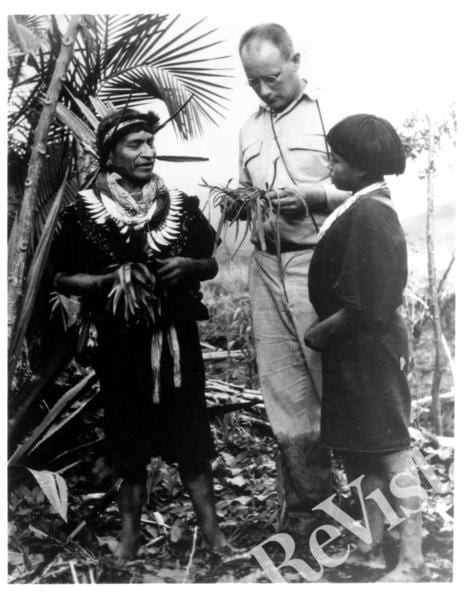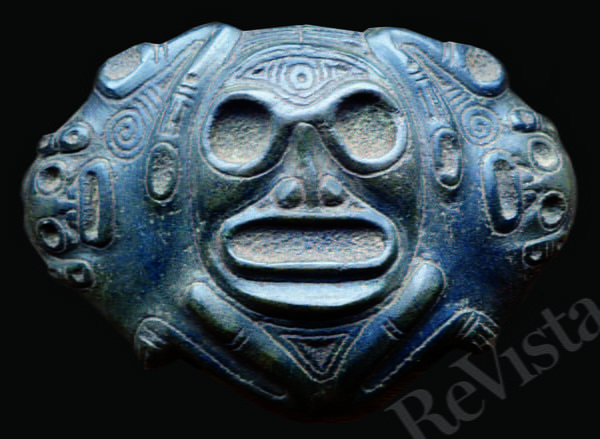The Biology of Consciousness
From William James to Richard Schultes
“I am neither a theologian, nor a scholar learned in the history of religions, nor an anthropologist. Psychology is the only branch of learning in which I am particularly versed. To the psychologist the religious propensities of man must be at least as interesting as any other of the facts pertaining to his mental constitution. It would seem, therefore, that, as a psychologist, the natural thing for me would be to invite you to a descriptive survey of those religious propensities.” —Williams James (On the Varieties of Religious Experience. Longmans, Green, & Co. 1902).
Substitute the word biology for psychology, and you’d have my consideration of consciousness—my own curiosity in writing about that subject parallels that of James about religion. His words, written more than a hundred years ago, have a sounding resonance with what and how I—as a biologist—have come to understand the realms of consciousness: “In my belief that a large acquaintance with particulars often makes us wiser than the possession of abstract formulas, however deep…” Therefore, in this work at least, William James, widely regarded as the father of American psychology, was what some would today call a phenomenologist (a concern with observations, case studies and the like that may be contrasted with purely theoretical approaches).
Trained in medicine, William James first taught physiology at Harvard and had absorbed Darwin’s view of evolution and in particular, the observation that ubiquitous random variation sometimes leads to evolutionary innovations. James was a scientist but did not favor what he termed scientism—the position of some fellow intellectuals who demurred from discussing certain subjects (presumably such as religion) as being outside their discipline, and unscientific (he named H. G. Wells and Bernard Shaw, among others). James thought broadly, and yet saw that all human behaviors are probably ultimately grounded in biology.
In offering some biological particulars, I wish to connect William James’ perspective on religion and consciousness with the work of another Harvard professor concerned with the particulars of human spiritual life, Richard Evans Schultes, known as the father of ethno-botany.
His lifelong work was documenting the indigenous uses of plants and fungi throughout the Americas, including in religious rituals. He began his Harvard career with an undergraduate senior thesis on the Kiowa peyote rituals in the southwestern United States, moved on in later years to identifying the species termed Ololiuqui (morning glory seeds containing LSD) and Teonánacatl (Psilocybe mushrooms) by the ancient Aztecs in Mexico, using images depicted in the few remaining Aztec codices, and finally, spent many years exploring the Amazon forests of Colombia and beyond, with shamans documenting ayahuasca rituals, and collecting tens of thousands of plant specimens now deposited in the Harvard University Herbaria.
Schultes wrote about his discoveries in scientific articles, influencing popular authors from Aldous Huxley and William Burroughs to Carlos Castaneda and Timothy Leary, who would then introduce them through books, magazine articles and interviews to the popular culture of the 1960s. Aldous Huxley (grandson of Darwin’s champion, Thomas Huxley), had perhaps the greatest influence through his book detailing his experiences with mescaline, the active compound in peyote, that had been described earlier by a German scientist as useful in studying the unconscious mind.
Probably nearly as influential as Huxley were a New York banker, R. Gordon Wasson and his spouse, Russian-born physician Valentina Pavlovna, who dedicated time and resources throughout their lives to documenting the uses of mushrooms by cultures worldwide. In 1957, Wasson traveled to Mexico with a photographer and recorded the Psilocybe shaman rituals, introducing the term magic mushrooms, and revealing their effects on perception to the beat and counter-cultural movement through a popular article published in Life magazine.
The link between James’ “religious propensities” and the use of consciousness-altering materials lies in the brain, so I will draw on recent work on the neurobiology of consciousness by Michael Graziano, Professor of Psychology and Neuroscience at Princeton University, Consciousness and the Social Brain (Oxford University Press, 2013).
One reason to be concerned with the biology of consciousness is the effect on our personal health. Remarkably enough, the power of conviction, or positive thinking, on health was also recognized by William James, who called this the mind-cure, and he attributed the remarkable longevity and vigor of a friend stricken with breast cancer to her ebullient approach to life and all around her. Today, we know that the placebo effect can be strong enough to produce results close to those of treatment, as evidenced for example, by control groups that receive sham surgery. As Jackson Pollock responded when he was once asked whether he was inspired by nature, “I am nature.” We are nature.
Sometime around 500 B.C., Hippocrates proposed that the brain is the source of the mind. The term consciousness itself was later defined by the English philosopher John Locke as the “perception of what passes in one’s own mind.” Long the domain of philosophers, the concept has since expanded to include the fields of psychology, neurobiology and behavior. All these disciplines agree that consciousness draws on our senses for information about the world outside of our minds, a world that provides the context for imagining our own place within it as well as the minds of others. As William James noted, consciousness is not a thing but a process.
Awareness is an important aspect of the process of consciousness. We are aware of the information coming from our senses, and of our bodies and memories, and we know we are aware of these things. We are also aware of the minds of others. There is nevertheless much that is subconscious, however, things of which we are not aware, and this is what William James viewed as psychology’s greatest discovery. As Graziano observes, awareness is a description of attention, and attention is a data-handling feature of neurons in a brain. We can also pay attention to input without necessarily being aware of the act, in that our neurons are continually registering information without our being conscious of it. Awareness is therefore a more or less rough sketch of attention, apparently evolved for processing complex and competing signals.
Consider the cacophony of sounds around you right now—sounds of traffic, footsteps, air-conditioning or fans— depending on where you happen to be. We pay little attention to most of these, much of the time, and none at all in the moment that a voice calls our name or the phone rings. A familiar video of selective attention shows that onlookers watching players passing a basketball do not even notice a gorilla dancing in the background. The diversity and range of our human senses are just what is required to make our way. We have no particular need to see ultraviolet light as does a bird or butterfly, or to sense electrical impulses like a fish. Nevertheless, even within our limited ranges of detection, the information from any one of our five senses, if unfiltered, would quickly overwhelm our attention.
Focused attention allows us to direct our neural resources towards processing one source at a time, enhancing depth of analysis, though at some evident cost of breadth of perception. One way to minimize this cost, of course, is to ignore some important stimuli only at the moment, but save the memory for processing later. Graziano believes that consciousness emerges from the neural machinery for selective attention. Recently, he has developed the Attention Schema Theory (AST) that posits that animals have evolved selective attention through sophisticated mechanisms for deep processing of some signals while ignoring others, and that consciousness is the result of the gradual evolution of such a system. Many examples of selective processing can be found at all levels in the nervous system, and overwhelming evidence now exists that consciousness is present in varying degrees across a wide range of animals, from frogs and lizards to birds and mammals.
Even in simple nervous systems, Graziano points out, neurons operate like candidates in an election, each shouting its message, trying to suppress the others; only a few winning signals end up influencing an animal’s behavior. For example, selective signal enhancement in the retinal cells in the eyes of most animals permit detection of edges that in turn enables distinguishing the outline of forms. Receptors involved in touch and hearing use signal enhancement in similar ways.
To enable selective attention among signals within and between senses, vertebrate animals have a special brain area, called the tectum, that is a central controller, coordinating and orienting the various sensory organs, eyes, ears and nose, towards important stimuli—perhaps a loud noise or sudden movement, and enabling what is called overt attention. To control the head and eyes, the tectum constructs an internal model of the world, a simulation that allows input and enables predictions. The tectum permits directed control of the major limbs and keeps track of where they are with respect to the outside world. When a frog moves its head, it expects the perspective of the outside landscape to move as well. It’s like a virtual reality simulation in the brain that allows a frog or fish to control its movements in the environment. Fish and frogs know where they are in the world. The energy cost in processing so much information is high, but evidently worth the price in terms of catching prey or avoiding predators. As Graziano points out, the frog has a pretty good internal model of itself, and, or course, we are more than frogs in many ways.
The first vertebrates to fully colonize dry land were reptiles, including the ancestors of birds, and these added another brain layer, the wulst, on top of the tectum as an enhanced controller. Rather than simply allowing a bird to react to outside stimuli, such as pinpointing a sudden sound or movement, the wulst allows lizards and birds to register a stimulus while also permitting a range of possible responses, such as fleeing, ignoring, or just remembering the moment for future reference.
Mammals have added a similar new brain layer called the cortex. The main difference between the tectum and the wulst/cortex is that tectum points the sensory organs towards a stimulus while the wulst/cortex permits focused attention without necessary action. In a 2002 Scientific American article, “The Problem of Consciousness,” Francis Crick (noted for co-discovering the DNA double helix) called this the spotlight of attention. The wulst/cortex can shift our attention from ourselves to a bystander, a jet flying overhead or any thought we wish, without overt movement on our part. In other words, the wulst/cortex permits virtual movement of attention from one thing to another.
The attention schema, using Graziano’s parlance, are the neural machinery used for modeling the attentional state of others as well as ourselves. The cues used can be body language, gaze direction, facial expressions, location of salient objects and prior knowledge. Our inner experiences of attention are like a moving image projected on a monitor. The portrayal is real enough to allow us to navigate but is not the physical reality itself. Magritte’s realistic painting of a pipe entitled “This is not a pipe,” is a famous recognition of this duality. According to Karl Friston of University College-London, the brain works by limiting our perception so as to permit focus and attention. Perception and evaluation, then, are intertwined—we usually see what we expect to see (sometimes quite literally—at the retinal blind spot that fills in from adjacent signals). Magicians take advantage of this and fool us through distraction into either seeing what is not there or not seeing what is in plain sight. We do rely on sophisticated internal models of the world that can therefore be fooled but we can also learn.
Culture is ultimately biological because we are biological beings with memories recorded by neurons, and consciousness, attention schema and perceptions shaped by experience and influencing behavior that, in turn, can be remembered. Humans (and some other animals) can also manipulate consciousness with behaviors that influence our internal physiology through exercise, meditation, exposure to outside stimuli or ingesting substances with physiological effects. Indeed, much research on consciousness has involved evaluating the effects of such influences.
As Schultes observed, indigenous peoples have been manipulating consciousness since prehistoric times, usually in the service of divination or religion. On Hispaniola, writing in 1496 on Columbus’ request, Fray Ramón Pane recorded that the Taino would use a snuff of ground, toasted cohoba seeds (Anadenanthera peregrina), in ceremonies of healing or supplication to gods represented by carved stone zemis. This snuff is called yopo throughout South America where it is still used by indigenous peoples, including in the region from where the Caribbean Taino originated near the Orinoco River some four to six thousand years ago. Schultes reported its use by the Incas and archeological evidence of use from throughout Central and South America.
In the Doors of Perception, Aldous Huxley’s 1954 influential volume, Huxley suggested that perception is widened by psychoactive substances, permitting access to a wider range of information concerning the world, and in particular, setting the stage for a return of the sense of awe, a sense that is key to William James’ conception of religion. Indeed MIT Professor of Divinity Huston Smith wrote that Huxley’s volume accurately depicted the use of psychoactive substances in ritual and religion by people around the world and throughout history and that it is possible that some religious views had their origins therein, long since forgotten. To experience such religious revelations firsthand, Smith and beat writer William Burroughs participated in the experiments with hallucinogens directed by Timothy Leary and Richard Alpert, then of the Harvard Department of Psychology.
The use of plants and fungi in altering consciousness in religious and shamanic rituals no doubt operates through altering the cortex control of these filters of perception. Regardless of whether they actually enhance receptivity of clues helpful in diagnosing illness or are otherwise useful in interacting with the world, their use together with the sights, sounds and scents of ritual would be a powerful reinforcement of belief by the participants.
William James viewed such strength of belief as the basis of religion, a diminution of self and adoption of an attitude of respect for the universe with a degree of conviction that is, in itself, empowering. James thought this faith was the power of religion rather than the veracity of a doctrine or particular truth or model about the universe. He felt that this conviction was shared by other experiences that also subjugate the self in service of a larger body, enterprises as disparate as military service, music participation (see ReVista, Fall 2015) or scientific investigations. Viewed this way, the soldier has something in common with the religious, scientific and the artistic mind, each with a sense of awe of something grander than the self, a sense that is empowering.
Graziano suggests that awareness arises from the interaction between self and other, via the attention schema; this is the process of consciousness according to William James. Because the number of such relationships are as many as there are things of which one is aware, one’s self-awareness is a moving point in a hyper-dimensional space of interactions.
However dimensional our personal space of awareness in terms of objects, it is multiplied by our relationships with other humans. Our status as a preeminently social species may have long determined a peculiarly human degree of awareness. Indeed, E. O. Wilson has suggested that ethics and morality are evolutionary outcomes of natural selection for sociality. Our senses of right and wrong, he suggests, correspond to acts that benefit others over the self, a form of altruism that would be highly beneficial in a society comprised of small social groups that depend on cooperation for survival. Certainly our ability to gauge the emotional states of others—drawing on gaze, body language, tone of voice and prior knowledge—bespeaks an organism adept at social interaction.
Shared cultural values, such as standards of beauty (in symmetry, color and proportion, for example), quality of music (e.g., emotional content of minor and major keys), as well as allegiance and identity with any group from the family to tribe, neighborhood, country or ethnic group, for instance, all reinforce identity and the social aspects of awareness. There is increasing evidence that the neurological basis of empathy may underlie our great sociability. Empathy is thought to involve mirror neurons, neurons in an observer that fire in response to awareness of another’s activity (involving the same neurons), such as music, dance or sports. Mirror neurons also operate in birds to coordinate duet-singing. Some animals, such as dogs, goats, crows and dolphins can judge the emotional states of others, including humans, by watching the gaze, enabling them to ask for assistance in some tasks, for example, or returning to move a coveted object that they are aware another may have seen them hide.
Understanding consciousness is one area in which the humanities and the sciences may do best to work together on research. Each side may discover and describe phenomena that may also be approachable by the other. In this way, William James brought consciousness from a subject only of philosophy to one of psychology. Researchers in human neurobiology like Michael Graziano at Princeton, and those such as Harvard’s Yun Zhang and Bence Olveczky who research other animals, are building bridges between psychology and biology.
The brain science discoveries are exciting to be sure, but are just the first scientific expeditions into territory first mapped by the humanities. The concepts of the arts, including social and political sciences, highlight phenomena of human culture and social interactions that science would not be able to predict. The future may hold an integrated approach to understanding, incorporating the approaches and phenomena today falling into one of the two great domains of knowledge, but at present we can strive to send each other messages in a language that is understood by both sides, a lingua franca.
We come back, in the end, to William James’ view of pragmatism. The mind and the world are inter-related to such a degree that it is challenging to describe one independently of the other. James’s view is that beliefs might better be judged by their “fruits, not by their roots.” In other words, James was an experimentalist and thought that beliefs could be judged by their usefulness, just as any other hypothesis.
“All models are wrong, but some are useful.” So observed the preeminent quantitative modeler, George Box. I might add that models can be useful in two ways, first as successive approximations to the truth, but also in providing a compass that lends overall direction through the world, a path forward. George Santayana, a contemporary of William James, criticized what he felt was James’ uncritical promotion of superstition because believing was the most important thing. I think he missed the point. Nevertheless, awareness of the biological roots of the mind, conscious and subconscious, may also serve us well in empowering our own lives of discovery.
Fall 2016, Volume XVI, Number 1
Brian D. Farrell is Professor of Organismic and Evolutionary Biology at Harvard University.
Related Articles
A Ditadura Acabada
The timing of the publication of the fifth and final volume of Elio Gaspari’s monumental history of the Brazilian military regime could not be more relevant. It is ironic that his new…
Spinning Mambo into Salsa: Caribbean Dance in Global Commerce
At a fancy yet packed bar in Tokyo’s most cosmopolitan district; at the patio of a bar in Vancouver facing the Canadian Rockies; at a hotel lounge bar overlooking the skyline of…
Teaching and Learning for the Twenty-First Century
In Teaching and Learning for the Twenty-First Century. Educational Goals, Policies and Curricula from Six Nations, Fernando Reimers and Connie K. Chung examine some policy issues in…






